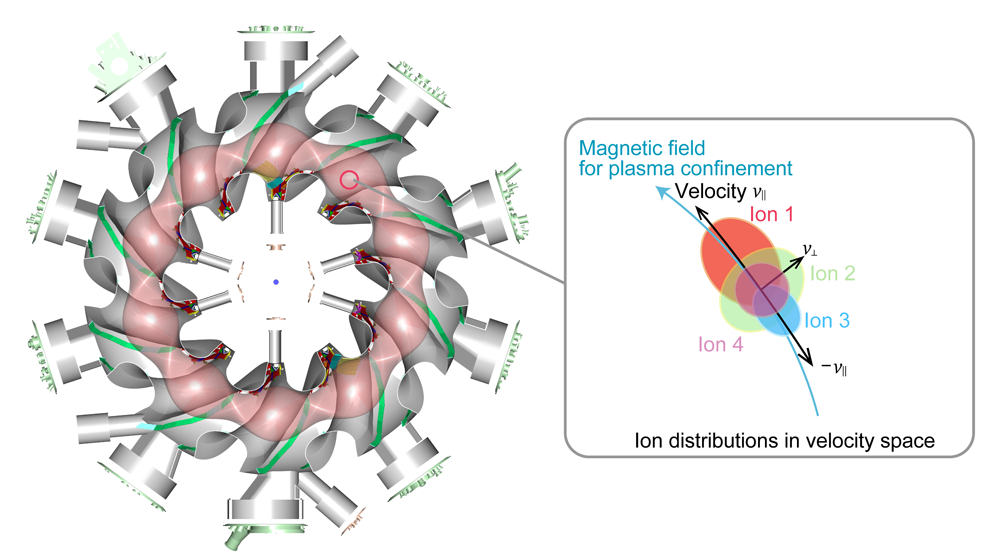Non-contact thermometer to measure
temperature of ultra-high temperature plasma
─ Successful observation of multi-temperature anisotropic energetic ions ─
Fusion plasma can maintain burning without external energy injection when the temperature at the center of the plasma exceeds 100 million degrees Celsius. Temperature measurement is also necessary to sustain such an ultra-high temperature plasma state. We have developed a new non-destructive high-precision calibration method for non-contact thermometers. Plasma experiments in the Large Helical Device (LHD) have revealed that plasmas heated to ultra-high temperatures have a complex mixture of energetic ions with a velocity spread in the direction of the confinement magnetic field and perpendicular to it. In addition to leading to the analysis of fusion reactor burning and control, these results are expected to be widely used for the calibration and analysis of plasma-heating devices and diagnostics using electromagnetic waves in fusion power plants.

In fusion plasmas, α-particles*1 generated by the fusion reaction between deuterium and tritium in the plasma, sustain the burning of the plasma and generate energy. Therefore, to realize nuclear fusion, it is necessary to know and control the state of the energetic α-particles generated in the high-temperature plasma. Although it is challenging to measure α-particles in high-temperature plasma, we considered non-contact measurement and started the development of collective Thomson scattering (CTS) measurement using electromagnetic waves.
The research team has reported on a method for evaluating ion temperature and velocity distribution, using scattering phenomena of millimeter electromagnetic waves*2. This study developed a high-precision in-situ calibration method for CTS measurements and applied it to temperature measurements in LHD plasmas. Conventionally, electron radiation in plasma is used to calibrate the receiver for CTS measurements. However, the local position of the emitted radiation was inaccurate due to refraction, and it was necessary to determine the location. To solve this problem, we combined the ray tracing calculation of electromagnetic waves with the calibration of receiver sensitivity by electron radiation. As a result, we succeeded in dramatically improving the reproducibility of the scattering spectrum. Furthermore, we have demonstrated that in-situ calibration is possible, using this method simultaneously with actual temperature measurements.
Using this method, we observed the scattering spectrum at the center of the LHD plasma by the CTS measurement. As expected from the model calculation of the scattering spectrum, the observed spectrum had an asymmetric shape (asymmetric when there was a population of ions with different velocities in the positive and negative directions of v|| in the figure). This asymmetry indicated complex confinement of anisotropic ions with parallel and perpendicular velocities to the magnetic field lines and was found to be due to plasma heating.
These results are essential for the study of confinement physics of alpha particles to maintain a self-burning state in fusion plasmas. Furthermore, since in-situ calibration*3 is also possible, it is expected to be widely used as a calibration and analysis method for electromagnetic heating devices and millimeter-wave measurement devices used in fusion power generation.
This research was conducted in collaboration with Masaki Nishiura and his research group at the National Institute for Fusion Science, Shun Adachi (a master's student at that time) at Kyushu University, Professor Shin Kubo at Chubu University, and Professor Teruo Saito at the University of Fukui.
This research result was published in Review of Scientific Instruments, a journal of the American Institute of Physics, on May 2, 2022.
Publication
- M. Nishiura, S. Adachi, K. Tanaka, N. Kenmochi, T. Shimozuma, R. Yanai, T. Saito, H. Nuga, R. Seki, "Collective Thomson scattering diagnostic with in situ calibration system for velocity space analysis in large helical device", Review of Scientific Instruments 93 (2022) 053501. [NIFS Repository]
Glossary
*1 alpha particle: Helium nuclei, produced in the fusion reaction between deuterium and tritium, are called alpha particles.
*2 Related research: http://dx.doi.org/10.1088/0029-5515/54/2/023006
*3 in-situ calibration: When the measurement environment changes, the state of the instrument may do also, resulting in a more significant error reflected in the measured value. It is possible to reduce the error by maintaining and calibrating the measurement environment, called in-situ calibration.
